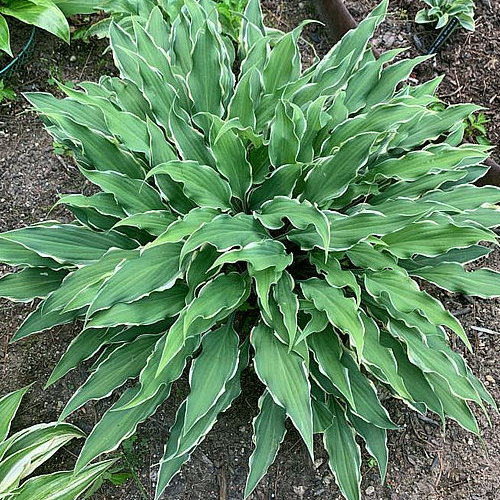The Happy Hosta
Kinky Boots Hosta
Regular price
$21.00 USD
Regular price
Sale price
$21.00 USD
Unit price
per
Shipping calculated at checkout.
Couldn't load pickup availability
Quart size
Hosta 'Kinky Boots' is a captivating hosta cultivar, a sport (natural genetic mutation) of H. 'Peek-a-boo Purple'. It is known for its striking foliage and attractive growth habit.
Key features
- Foliage: Medium blue-green leaves with a contrasting creamy white margin that initially appears yellow before transitioning to white in the summer. The leaves have a wavy, ruffled, lightly corrugated, and slightly twisted appearance.
- Petioles (leaf stalks): Burgundy in color, creating a striking contrast with the leaves and adding to its visual appeal. The "open flared mound" of the plant helps showcase the red petioles.
- Flowers: Produces pale lavender, tubular flowers with medium lavender centers on red scapes (flower stalks) during mid to late summer.
- Size: A medium-sized hosta, reaching a mature height of approximately 13 inches (33 cm) and a spread of 34 inches (86 cm). Another source indicates a mature height of 18-24 inches and a spread of 24-36 inches.
- Growth Habit: Forms a vigorous, clumping mound. It has a moderate growth rate, typically reaching full size within 3 to 5 years.
Growing conditions
- Light: Prefers partial to full shade, thriving best in locations with dappled light throughout the day. It's important to protect it from direct, intense sunlight, especially hot afternoon sun, which can scorch the leaves.
- Soil: Requires moist, fertile, and well-drained soil, ideally with a slightly acidic to neutral pH (6.0-7.0). Adding organic matter like compost or rotted manure improves soil quality.
- Watering: Needs consistent moisture but dislikes sitting in wet soil, which can lead to root rot. Water deeply and regularly, especially during dry periods or when grown under trees.
- Hardiness: Hardy in USDA Zones 3a-8b.
Care and maintenance
- Fertilizing: Apply a balanced slow-release fertilizer in early spring and again in mid-summer. Alternatively, fertilize in the spring with compost and an all-purpose organic product.
- Pruning: Remove dead or damaged leaves in early spring to encourage new growth. Deadhead spent flower stalks after blooming to promote new growth and prevent seed formation.
- Pests and Diseases: Generally resistant to common pests like deer and rabbits, but can be susceptible to slugs, snails, spider mites, and aphids. Regular monitoring and timely intervention are important to keep the plant healthy.

